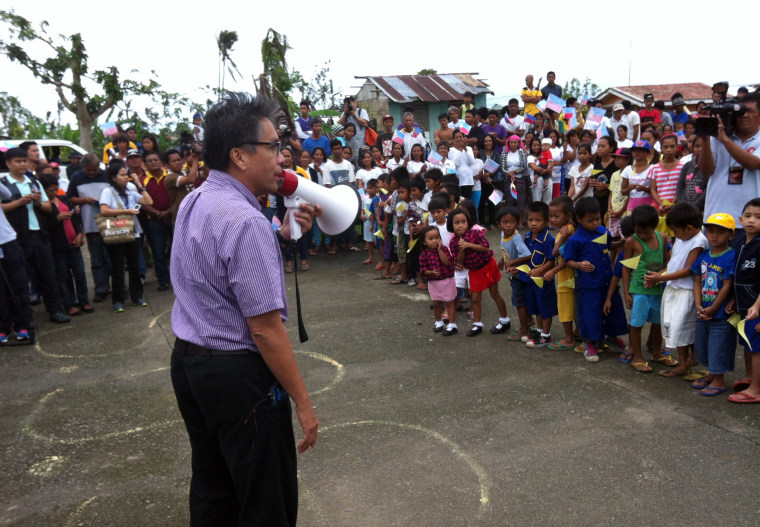'Nothing's changed': Philippine typhoon survivors fear being forgotten
TACLOBAN CITY, Philippines – It’s been almost three months since Typhoon Haiyan – or Yolanda, as it’s called by Filipinos – struck this part of Leyte province with a force stronger than Katrina or Sandy, killing at least 6,000 people. More than 2,000 are still missing, presumed dead.But the devastation left in the wake of a 20-foot storm surge is largely off the front pages these days. T
TACLOBAN CITY, Philippines – It’s been almost three months since Typhoon Haiyan – or Yolanda, as it’s called by Filipinos – struck this part of Leyte province with a force stronger than Katrina or Sandy, killing at least 6,000 people. More than 2,000 are still missing, presumed dead.
But the devastation left in the wake of a 20-foot storm surge is largely off the front pages these days. Thanks to a massive international relief effort, survivors have some kind of shelter, if only a U.N.-issued blue tarpaulin that serves as a roof during the current rainy season. Few are now going hungry. Children are mostly back in school, usually inside makeshift tents.
But officials like Remedios Petilla, mayor of Palo in the central Philippines, are still worried.
“We’re not over the hump yet. Although we’ve made several steps toward it, it’s not over yet," said Petilla.
As we spoke, people stood patiently in line waiting for 20 pounds of rice, sardines, high-energy biscuits and matches that make up each emergency food pack, enough to sustain a family of five for about a week.
In between piling the food bags and thermal blankets into the outstretched arms of expectant survivors, Petilla explained what living through the world’s worst storm has meant to her.
“I am the mayor of a town of 67,000 – that’s 17,000 families,” she said. “There is not one family in my town that wasn’t hit by the super typhoon.”
Just as their needs have shifted from emergency aid to long-term rehabilitation, an increasing number of aid organizations appear to be packing up and going home.
NGOs leaving
“We saw this in Haiti and we’re seeing it again here in the Philippines,” said one Western aid worker from Communicare, a non-governmental organization that specializes in broadcast communication. He asked not to be identified.
“The NGOs come in by the dozens, flex their muscles and spend their budgets in front of the news cameras, but when push comes to shove and victims need help dealing with long-term issues – like getting back their livelihoods or homes – they're gone,” he said.
In Magellanes, the shanty port in Tacloban City where mostly fishermen lived and plied their trade until Haiyan wiped out their boats, Rowena Esperes stood in line for two hours. She had no idea what she might eventually receive – food, clothes, blankets. She said she didn’t really care. Her family needed everything.
Esperes (which, ironically, means “you hope” in Spanish) said that waiting for things to improve was becoming unbearable.
“We still live in an evacuation center. There’s no running water, no sanitation. It’s impossible to have a proper sleep. And rice is all we’ve eaten for weeks,” she said.
Manuel Roxas, the Secretary of Interior, has become “Mr. Fix-It” for many Filipinos, as he’s hopped islands by helicopter to troubleshoot the crisis, making sure all the international aid actually gets to recipients.

As we surveyed the Tacloban area from a Philippine Air Force helicopter, Roxas defended his government’s response, first with emergency food, tarps and tents, and now with plans to build cement and steel structures – a $1 billion rehabilitation program.
“You have to remember, after Yolanda there was nothing – no power, no water, no communications. No one could even listen to a radio to figure out ‘Where do I go?’ and ‘What’s happening?’” said Roxas. “Now at least people have their dignity back. They have their wits about them.”
‘We still need shelter, food, clothing’
But the positive message was lost on Belena Hinacay, a college graduate. Most of her relatives and neighbors drowned in a flimsy evacuation center.
“It’s the same. Nothing’s changed. We still need shelter, food, clothing and most of all, jobs.”
There is a “cash for work” system that has paid out a few precious dollars per day to thousands of volunteers who have swept up the equivalent of a dozen football fields of debris.
Didn’t Hinacay get money from her local “cash for work” program?
“No. They said we’d be paid after one week but it’s now almost two weeks and we’ve received nothing.”
As we toured an outdoor market that had just reopened for business in a neighboring town, I asked Roxas what message he had for the many like Hinacay.
“I’m not saying it’s over. Things continue to be hard – 60 percent of people still don’t have power. But at least they have some direction and they’re thinking about rebuilding their lives.”
No one we spoke to thought recovery would take less than years. And every survivor said they prayed the world wouldn’t forget them before then.
Jim Maceda is an NBC News foreign correspondent based in London who has covered the Philippines extensively since the 1980s.
Related